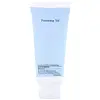What's inside
What's inside
 Key Ingredients
Key Ingredients

 Benefits
Benefits

 Concerns
Concerns

 Ingredients Side-by-side
Ingredients Side-by-side

Water
Skin ConditioningGlycerin
HumectantPalmitic Acid
EmollientStearic Acid
CleansingMyristic Acid
CleansingPotassium Hydroxide
BufferingLauric Acid
CleansingCocamidopropyl Betaine
CleansingSodium Bicarbonate
AbrasiveTea-Lauryl Sulfate
CleansingSodium Chloride
MaskingAcrylates/C10-30 Alkyl Acrylate Crosspolymer
Emulsion StabilisingArachidic Acid
CleansingCellulose Gum
Emulsion StabilisingCapric Acid
CleansingSodium Benzoate
MaskingDisodium EDTA
Phenoxyethanol
PreservativeParfum
MaskingLinalool
PerfumingLimonene
PerfumingWater, Glycerin, Palmitic Acid, Stearic Acid, Myristic Acid, Potassium Hydroxide, Lauric Acid, Cocamidopropyl Betaine, Sodium Bicarbonate, Tea-Lauryl Sulfate, Sodium Chloride, Acrylates/C10-30 Alkyl Acrylate Crosspolymer, Arachidic Acid, Cellulose Gum, Capric Acid, Sodium Benzoate, Disodium EDTA, Phenoxyethanol, Parfum, Linalool, Limonene
Water
Skin ConditioningSodium Cocoyl Isethionate
CleansingGlycerin
HumectantCoconut Acid
CleansingPolyquaternium-67
1,2-Hexanediol
Skin ConditioningSodium Isethionate
CleansingSodium Methyl Cocoyl Taurate
CleansingLitsea Cubeba Fruit Oil
MaskingSodium Chloride
MaskingDisodium EDTA
Ethylhexylglycerin
Skin ConditioningSodium Acetate
BufferingButylene Glycol
HumectantCentella Asiatica Extract
CleansingPortulaca Oleracea Extract
Skin ConditioningCamellia Sinensis Leaf Extract
AntimicrobialHamamelis Virginiana Extract
AntiseborrhoeicSodium Hyaluronate
HumectantBeta-Glucan
Skin ConditioningMelaleuca Alternifolia Leaf Extract
PerfumingPhaseolus Angularis Seed Extract
AntioxidantPentylene Glycol
Skin ConditioningCaprylyl Glycol
EmollientDiatomaceous Earth
AbrasiveIsopropyl Alcohol
SolventCitric Acid
BufferingWater, Sodium Cocoyl Isethionate, Glycerin, Coconut Acid, Polyquaternium-67, 1,2-Hexanediol, Sodium Isethionate, Sodium Methyl Cocoyl Taurate, Litsea Cubeba Fruit Oil, Sodium Chloride, Disodium EDTA, Ethylhexylglycerin, Sodium Acetate, Butylene Glycol, Centella Asiatica Extract, Portulaca Oleracea Extract, Camellia Sinensis Leaf Extract, Hamamelis Virginiana Extract, Sodium Hyaluronate, Beta-Glucan, Melaleuca Alternifolia Leaf Extract, Phaseolus Angularis Seed Extract, Pentylene Glycol, Caprylyl Glycol, Diatomaceous Earth, Isopropyl Alcohol, Citric Acid
 Reviews
Reviews

Ingredients Explained
These ingredients are found in both products.
Ingredients higher up in an ingredient list are typically present in a larger amount.
Disodium EDTA plays a role in making products more stable by aiding other preservatives.
It is a chelating agent, meaning it neutralizes metal ions that may be found in a product.
Disodium EDTA is a salt of edetic acid and is found to be safe in cosmetic ingredients.
Learn more about Disodium EDTAGlycerin is already naturally found in your skin. It helps moisturize and protect your skin.
A study from 2016 found glycerin to be more effective as a humectant than AHAs and hyaluronic acid.
As a humectant, it helps the skin stay hydrated by pulling moisture to your skin. The low molecular weight of glycerin allows it to pull moisture into the deeper layers of your skin.
Hydrated skin improves your skin barrier; Your skin barrier helps protect against irritants and bacteria.
Glycerin has also been found to have antimicrobial and antiviral properties. Due to these properties, glycerin is often used in wound and burn treatments.
In cosmetics, glycerin is usually derived from plants such as soybean or palm. However, it can also be sourced from animals, such as tallow or animal fat.
This ingredient is organic, colorless, odorless, and non-toxic.
Glycerin is the name for this ingredient in American English. British English uses Glycerol/Glycerine.
Learn more about GlycerinChances are, you eat sodium chloride every day. Sodium Chloride is also known as table salt.
This ingredient has many purposes in skincare: thickener, emulsifier, and exfoliator.
You'll most likely find this ingredient in cleansers where it is used to create a gel-like texture. As an emulsifier, it also prevents ingredients from separating.
There is much debate on whether this ingredient is comedogenic. The short answer - comedogenic ratings don't tell the whole story. Learn more about comegodenic ratings here.
The concensus about this ingredient causing acne seems to be divided. Research is needed to understand if this ingredient does cause acne.
Scrubs may use salt as the primary exfoliating ingredient.
Learn more about Sodium ChlorideWater. It's the most common cosmetic ingredient of all. You'll usually see it at the top of ingredient lists, meaning that it makes up the largest part of the product.
So why is it so popular? Water most often acts as a solvent - this means that it helps dissolve other ingredients into the formulation.
You'll also recognize water as that liquid we all need to stay alive. If you see this, drink a glass of water. Stay hydrated!
Learn more about Water